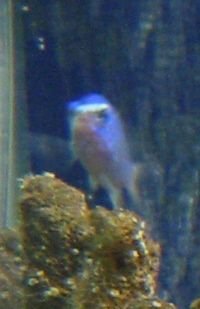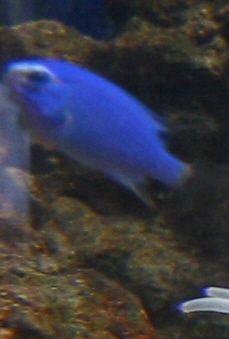it may be 1 of theseIch/White Spot: This is probably one of the most common fish diseases. Ich looks like literally white spots all over the fish. This is a Protozoan disease caused by Ichthyophthirius in fresh water aqauriums (Cryptocarion irritans in Marine). It is a parasite that attacks the eyes, fins, gills, skin and mouth interior.
Symptoms: White spots all over the fish. The fish may attempt to scrape itself against objects in the aquarium, have a loss of appetite or a stressed-rapid breathing. The parasite can only be affected by treatment during the free-swimming stages of the cycle.
Treatment : A Copper Sulfate or Copper Formalin medicine should be able to kill most infections. There are many medicines all do the trick. If the fish are salt tolerant give your fish a salt bath. Also raise the temp this ups the life cycle of the disgusting parasite.
Velvet Similar to ich except the white spots appear 'dusty'.
Symptoms Same as ich except dusty spots
Treatment Same as ich
Dropsy : One of the most disturbing of fish diseases, and is rarely cureable. Dropsy is an internal bacterial infection.
Symptoms: The fish's scales will stand out, making it have a pine comb look. Sometimes eyes can .blow up'.
Treatment : Use Kanamycin or Tetracycline and raise the temperature to about 80 degrees/ 30 deg C. This helps remove the fluid note this is rarly curablee.
Fungus:: Common disease that effects all kinds tropical fish. Fungus mostly infects in poor water conditions in which there are unacceptable levels of ammonia or nitrites. Fin nippers will damage the fins of other fish making them more susceptible to fungal infections and external bacterial infections such as fin and tail rot.
Symptoms A white cottony fluff will appear on fish. Can be around body or in mouth. Fin rot appears as white on ends of fins.
Treatment: Relatively easy. Add appropriate medication (Available for all fungal infections). If fish are salt tolerant add salt. Raise the temp to 30 deg C or 80deg F.
Swimbladder: This is a disease that effects the fishes swim bladder.
Symptoms: Fish swim side-ways or rest on bottom and can't go to surface.
Treatment: Raise the temperature, add appropriate medication for swim bladder. Note this is a disease that is rarely curable.
Cysts This is a uncommon disease. Fish infected by systs should be ethunaised before the cyst bursts.
Symptoms: Large balls appear on fish internally or externally. They look full of fluid and are relatively largeCataractsCataracts are fungal growths on the eyes. Treatment with any aquarium fungicide should work. Its probability increases with water rich in ammonia or nitrates.
Symptoms:White or gray material covering the eyes only.
Treatment

pecial attention should be made to assure that ammonia and nitrite levels stay within accepted measures. Add anti fugal treatment. Raise the temperature and if fish are compatible with salt add it.
CorneybacteriosisCorneybacteria causes swelling in the head which will push the eyes outward. It is caused by overcrowding and water of poor quality, having an excess of ammonia and / or nitrites. (YOU KNOW SEE WHY WE GO ON AND ON ABOUT AMMONIA/NITRITES )
Symptoms Bulging Eyes
Treatment:There are a few commercially available products which treat corneybacteriosis Penicillin and tetracycline are among them.
Black Spot Black Spot, or diplopstomiasis, often follows the addition of new aquarium fish. All fish are susceptible, especially the Silver Dollar and Piranha. It is fairly easy to diagnose and treat.
Symptoms Small black spots on the body.
Treatment Black spot is generally easy to cure. There are a number of commercially available treatments and preventatives.
VelvetVelvet looks similar to Ich, but there will be many more small white spots that appear dusty. This Protozoan disease in fresh water environments is caused by Oodinium limneticum and Oodinium pillularis. In marine environments by Oodinium occellatum. The parasite attacks the eyes, fins, gills and skin.
Symptoms: Similar to Ich more white spots that appear dusty
Treatment As for Ich
Fin Rot Can be either bacterial (fins rot with red [blood] outline on edge) or fungal (white, cottony grows on edge of fin)
Symptoms The fins will have a ragged, uneven appearance that will eventually, if left untreated, disintegrate to the point where only a stub remains.
Treatment There is a range of medication including penecilin.
Hole In The Head (HITH): This is a common disease among larger Cichlids such as Severums and especially...Oscars. It appears as small holes on the face and around the eyes, that may have a white material growing inside them.
SymptomsIt appears as small holes on the face and around the eyes, that may have a white material growing inside them. Loss of appetite and whitish feces are another indication that may appear before the development of the holes.
Treatmeant A range of medication including Aquarium Pharmaceuticals-General Cure, Aquatronics- Hex-a-Mit, Aquatronics- Hex-A-Vital (especially for Discus, Angelfish and Oscars)
Gill Flukes Parasite livign in gills. Gills become inflamed.
Symptoms: The gills may turn red and swollen. The fish may scratch himself against objects and breathe rapidly.
Treatment Use appropriate medication and raise the temp and if possible give a salt bath.
Flexibacter Flexibacter is a gliding bacteria. These bacteria are long, thin, and flexible. One end of the bacterial cell is attached to the fish, while the other end if free floating.
Symptoms: Looks like fuzzyness basically. Balls that look like mold.
Treatment Appropriate medication (Maracyn and Maracyn II used together). Increased aeration, and decreased temperature.
Tumor There are 2 types of tumors. The Benign and Cancerous tumor.
Symptoms: The benign tumour will have something that looks like an infection around it. A Cancerous tumour will keep growing and some scales around the area will protrude when it grows big enough.
Treatment: Sadly no cure. Either euthanise the fish reccomended or let it live in agony for its remaing days.
Clamped fins The fish clamps its fins close against the its body. Experienced aquarists use this to quickly spot problems with their fish.
Symptoms Like the name clammped fins.
Treatment: Water change (Like with all diseases) add melafix or some sort of appropriate medication. If possible add salt to compatible fish.



 pecial attention should be made to assure that ammonia and nitrite levels stay within accepted measures. Add anti fugal treatment. Raise the temperature and if fish are compatible with salt add it.
pecial attention should be made to assure that ammonia and nitrite levels stay within accepted measures. Add anti fugal treatment. Raise the temperature and if fish are compatible with salt add it.  this fish is the first fish i bought and he has been so sweet. i dont want to loose him but i have no clue what to do for him. i am going to my lfs to see what they think.
this fish is the first fish i bought and he has been so sweet. i dont want to loose him but i have no clue what to do for him. i am going to my lfs to see what they think. 